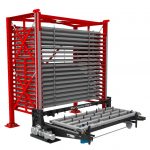Vertical lifts allow shops to control inventory safely
The growing movement toward smaller order sizes and just-in-time delivery has placed very high demands on all aspects of manufacturing, including sheet metal forming.
But, not all aspects of sheet metal forming are quite so automated. The storage and supply of sheet metal to processing machines, is one such area. Although most high-volume metalworking manufacturers utilize highly automated and usually complex lift systems for storing sheet metal and releasing it into production, most medium- to smaller-volume manufacturers still manage this operation with fixed racking and forklifts.
Such manual storage and material handling procedures not only consume large areas of valuable production space, and are highly labor intensive, but they also frequently require interruption of adjacent production areas, slowing throughput, and increasing the probability of workplace accidents.
Safety is key
Safety is, of course, a serious issue in sheet metal work. One area of critical focus is forklift safety.
Forklifts are used for carrying and transporting heavy materials in primarily non-roadway areas. The forklift category also includes order pickers and powered platform trucks. The forklift designation describes the source of the injury, not the event. Forklift-related injuries are also cross-categorized by event type, most often as either a transportation incident, or contact with object or equipment incident. Forklifts were the source of 85 work-related deaths and 7,940 nonfatal injuries involving days away from work in 2018.
The machine can be adapted for the storage of bar stock, press brake dies and punches. Metalworking manufacturing operations that implement effective safety and health management systems may expect to significantly reduce injuries and illnesses, and reduce the costs associated with these injuries and illnesses, including workers’ compensation payments, medical expenses, and lost productivity. In addition, such manufacturers often find that process and other changes made to improve workplace safety and health may result in significant improvements to productivity and profitability.
Despite these safety concerns and potential benefits, the vast majority of small-to-medium-size metalworking manufacturers have not availed themselves of automated systems for sheet metal storage. Instead, they continue to rely on forklifts to facilitate the movement of sheet metal in and out of stationary storage racks, risking the potential for worker injury.
Automated sheet metal vertical lifts
This scenario may now be changing for low-to-medium-volume sheet metal manufacturers. A new generation of automated sheet metal vertical lifts, now enable low- to medium-volume sheet metal manufacturers to easily access automated storage within their production areas. Different from vertical lifts used to service high-volume production areas, these new fully automated systems are designed for smaller sheet metal volumes.
One such system is Vidir Machine. Like the bigger systems, the Vidir lift can be adapted for the storage of sheet metal, bar stock, press brake dies and punches, and other industrial materials.
Designed to feed processing centers, and specifically sheet lasers directly, the sheet metal lift creates a storage center capable of continuously feeding production machines to minimize downtime and increase operational efficiency.
A single unit can have 20 to 30 storage locations. The system can be configured between 10 feet and 24 feet in height, with up to 38 shelf storage positions, for storage with pallets or without, each capable of supporting 5,000 pounds
Once the sheet metal, roll bar or die is accessed by the operator, it can be transported to the process machine via suction device, or carried by forklift at a low, relatively safe height. These new-generation lifts greatly remove the forklift from the equation. “Vidir developed this lift storage system as a base-level machine,” We developed this unit so manufacturers could load at a safe height, and the machine could then do the put-away. It incorporates a single rack with 20 to 30 storage locations that would serve as a supply point to several presses or laser cutters.”
Improved operational efficiency
New-generation automated sheet metal storage systems increase workplace safety and product security by providing a secure and controlled delivery method for heavy pallets of sheet metal stored overhead. Manufacturers can reduce their storage footprint by combining multiple sheet metal racks into a single tower that feeds processing machines directly. The added accessibility, increased storage, and improved material flow will increase efficiency resulting in a tangible ROI.
No longer do sections of the shop have to temporarily shut down to allow for forklift manipulation of large loads suspended near their work areas. No longer do workers have to be pulled from their assigned production tasks to spot these forklift loads, which impacts labor costs. No longer do manufacturers have to absorb the costs of facility, material and product damage from forklift usage. These are tangible benefits that can be realized by any metal facility.
Shorter runs and just-in-time ordering are necessitating more frequent changeovers, which means more frequent access to metal storage locations, and more frequent maneuvering of suspended loads with forklifts. These factors are driving small- and medium-volume sheet metal manufacturers to rethink their operational processes. Incorporating vertical lifts is one way they can achieve efficiencies.



